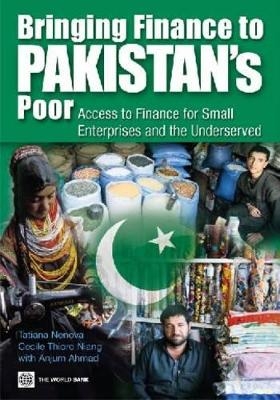
Bringing Finance to Pakistan's Poor
Access to Finance for Small Enterprises and the Underserved
Seiten
2009
World Bank Publications
978-0-8213-8030-7 (ISBN)
World Bank Publications
978-0-8213-8030-7 (ISBN)
- Titel z.Zt. nicht lieferbar
- Versandkostenfrei
- Auch auf Rechnung
- Artikel merken
A report that provides an analysis of Pakistan's relationship with the financial sector. It examines regulatory and institutional arrangements and proposes development options, building on international practice examples.
Although access to financing in Pakistan is expanding quickly, it is two to four times lower than regional benchmarks. Half of Pakistani adults, mostly women, do not engage with the financial system at all, and only 14 percent have access to formal services. Credit for small- and medium-size enterprises is rationed by the financial system. The formal microfinance sector reaches less than 2 percent of the poor, as opposed to more than 25 percent in neighboring countries. Yet it is the micro- and small businesses, along with remittances, that help families escape the poverty trap and participate in the economy. 'Bringing Finance to Pakistan's Poor' is based on a pioneering and comprehensive survey and dataset that measures the access to financial products by Pakistani households. The survey included 10,305 households in all areas of the country, excluding the tribal regions. The accompanying CD contains summary statistics. The authors develop a picture of access to and usage of financial services across the country and across different population groups, and they identify policy and regulatory priorities.
Reform measures in Pakistan have been timely, but alone are not enough; financial institutions have lagged behind in adopting technology, segmenting customer bases, diversifying products, and simplifying processes and procedures. Gender bias and low levels of financial literacy remain barriers, as is geographical remoteness. However, the single strongest cause of low financial access is lack of income-not location, education, or even gender. 'Bringing Finance to Pakistan's Poor' will be of great interest to readers working in the areas of business and finance, economic policy, gender and rural development, and microfinance.
Although access to financing in Pakistan is expanding quickly, it is two to four times lower than regional benchmarks. Half of Pakistani adults, mostly women, do not engage with the financial system at all, and only 14 percent have access to formal services. Credit for small- and medium-size enterprises is rationed by the financial system. The formal microfinance sector reaches less than 2 percent of the poor, as opposed to more than 25 percent in neighboring countries. Yet it is the micro- and small businesses, along with remittances, that help families escape the poverty trap and participate in the economy. 'Bringing Finance to Pakistan's Poor' is based on a pioneering and comprehensive survey and dataset that measures the access to financial products by Pakistani households. The survey included 10,305 households in all areas of the country, excluding the tribal regions. The accompanying CD contains summary statistics. The authors develop a picture of access to and usage of financial services across the country and across different population groups, and they identify policy and regulatory priorities.
Reform measures in Pakistan have been timely, but alone are not enough; financial institutions have lagged behind in adopting technology, segmenting customer bases, diversifying products, and simplifying processes and procedures. Gender bias and low levels of financial literacy remain barriers, as is geographical remoteness. However, the single strongest cause of low financial access is lack of income-not location, education, or even gender. 'Bringing Finance to Pakistan's Poor' will be of great interest to readers working in the areas of business and finance, economic policy, gender and rural development, and microfinance.
| Erscheint lt. Verlag | 1.12.2009 |
|---|---|
| Verlagsort | Washington |
| Sprache | englisch |
| Maße | 175 x 251 mm |
| Gewicht | 654 g |
| Themenwelt | Wirtschaft ► Volkswirtschaftslehre ► Finanzwissenschaft |
| Wirtschaft ► Volkswirtschaftslehre ► Makroökonomie | |
| ISBN-10 | 0-8213-8030-3 / 0821380303 |
| ISBN-13 | 978-0-8213-8030-7 / 9780821380307 |
| Zustand | Neuware |
| Haben Sie eine Frage zum Produkt? |
Mehr entdecken
aus dem Bereich
aus dem Bereich
Media-Kombination (2024)
Pearson Education Limited
CHF 137,75
![International Finance: Theory and Policy plus Pearson MyLab Economics with Pearson eText [Global Edition] - Paul Krugman; Maurice Obstfeld; Marc Melitz](/media/101959212)